Mulesoft MuleSoft Certified Developer-Level 1 MuleSoft Certified Developer-Level 1 (Mule 4) Online Training
Mulesoft MuleSoft Certified Developer-Level 1 Online Training
The questions for MuleSoft Certified Developer-Level 1 were last updated at Feb 28,2025.
- Exam Code: MuleSoft Certified Developer-Level 1
- Exam Name: MuleSoft Certified Developer-Level 1 (Mule 4)
- Certification Provider: Mulesoft
- Latest update: Feb 28,2025
Refer to the exhibits.
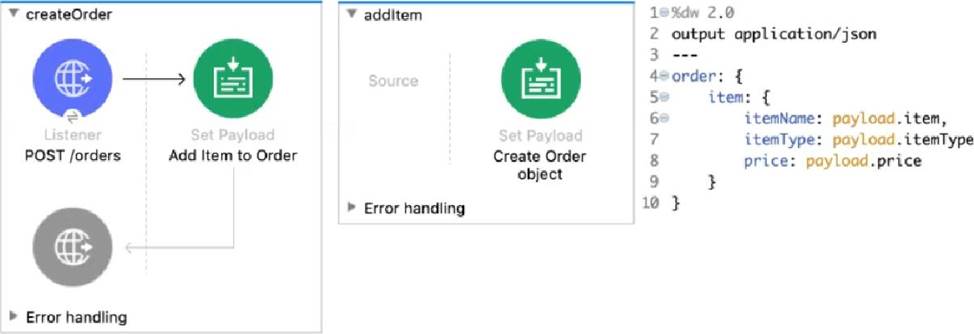
The Set Payload transformer in the addltem child flow uses DataWeave to create an order object.
What is the correct DataWeave code for the Set Payload transformer in the createOrder flow to use the addltem child flow to add a router call with the price of 100 to the order?
- A . lookup( "addltern", { price: "100", item: "router", itemType: "cable" } )
- B . addltem( { payload: { price: "100", item: "router", itemType: "cable" > } )
- C . lookup( "addltem", { payload: { price: "100", item: "router", itemType: "cable" } > )
- D . addltem( { price: "100", item: "router", itemType: "cable" } )
An HTTP Request operation sends an HTTP request with a non-empty JSON object payload to an external HTTP endpoint. The response from the external HTTP endpoint returns an XML body. The result is stored in a target named the Result.
What is the payload at the event processor after the HTTP Request?
- A . The XML response body
- B . null
- C . The original JSON request body
- D . A non-empty Java object
Refer to the exhibit.
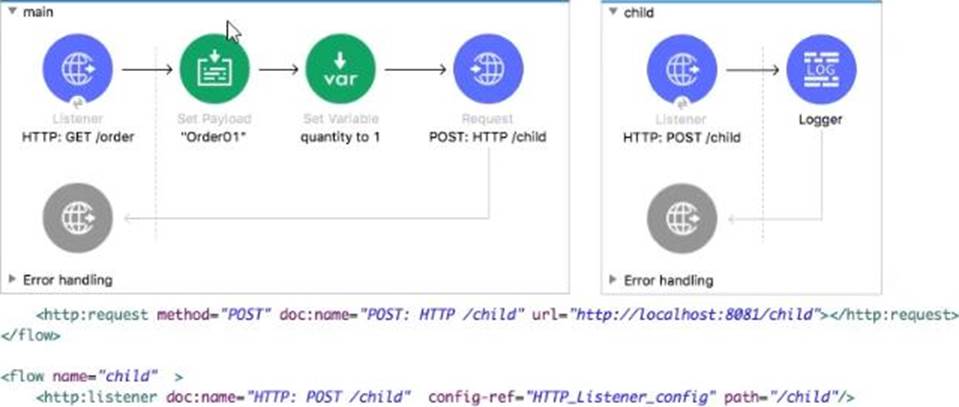
The main flow contains an HTTP Request in the middle of the flow.
The HTTP Listeners and HTTP request use default configurations.
What values are accessible to the Logger at the end of the flow after a web client submit request to http://local:801/order?color=red?
- A . payload
- B . payload quantity var
- C . payload color query param
- D . payload quantity var color query param
B
Explanation:
Correct answer is as below. Query parameters are replaced when external HTTP call is invoked.
payload
producer var
An API implementation has been deployed to CloudHub and now needs to be governed. IT will not allocate additional vCore for a new Mule application to act as an API proxy.
What is the next step to preseive the current vCore usage, but still allow the Mule application to be managed by API Manager?
- A . Register the same API implementation in Runtime Manager to connect to API Manager
- B . Modify the API implementation to use auto-discovery to register with API Manager
- C . Upload the Mule application’s JAR file to the API instance in API Manager
- D . Deploy the same API implementation behind a VPC and configure the VPC to connect to API Manager
B
Explanation:
Correct answer is Modify the API implementation to use auto-discovery to register with API Manager
API Autodiscovery
Configuring autodiscovery allows a deployed Mule runtime engine (Mule) application to connect with API Manager to download and manage policies and to generate analytics data. Additionally, with autodiscovery, you can configure your Mule applications to act as their own API proxy.
When autodiscovery is correctly configured in your Mule application, you can say that your application’s API is tracked by (green dot) or paired to API Manager. You can associate an API in a Mule setup with only one autodiscovery instance at a given time.
MuleSoft Doc
Ref: https://docs.mulesoft.com/api-manager/2.x/api-auto-discovery-new-concept
What HTTP method in a RESTful web service is typically used to completely replace an existing resource?
- A . GET
- B . PATCH
- C . PUT
- D . POST
C
Explanation:
PUT replaces the original version of the resource, whereas the PATCH method supplies a set of instructions to modify the resource
Refer to the exhibits.
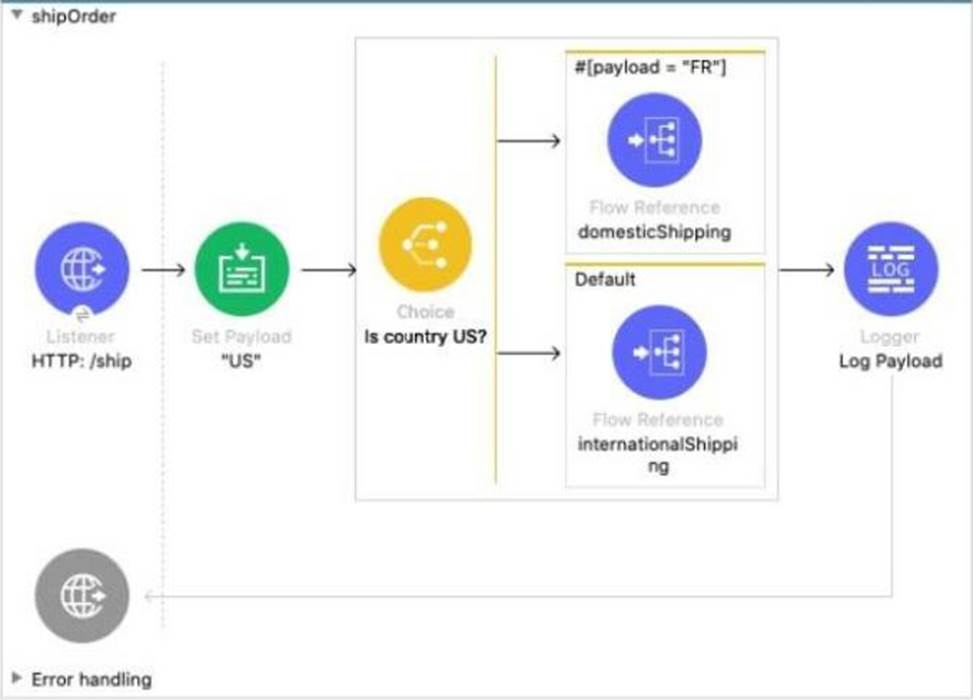
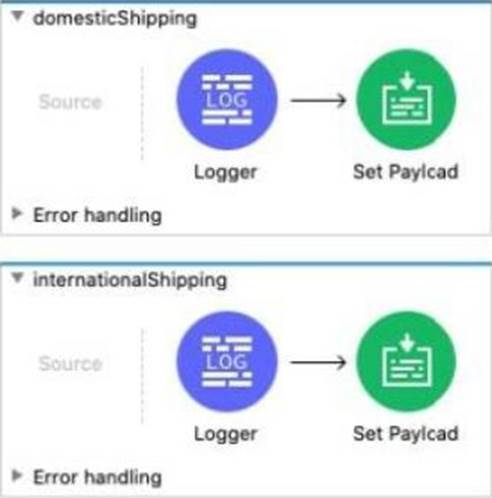
In the Choice router, the When expression for the domesticShipping route is set to "#[payload = ‘FR’]".
What is logged after the Choice router completes?
- A . A string with value "FR"
- B . A DataVVeave syntax error
- C . The result of the intemationalShipping flow
- D . The result of the domesticShipoing flow
Refer to the exhibits.
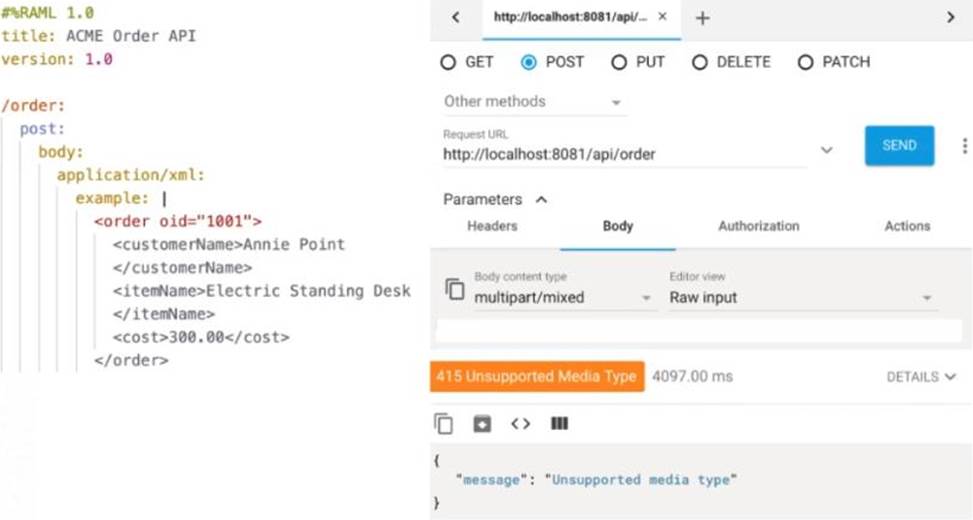
The web client sends a POST request to the ACME Order API with an XML payload. An error is returned.
What should be changed in the request so that a success response code is returned to the web client?
- A . Set a request header with the name Content-Type to a value of applicatron/octet-stream
- B . Set a request header with the name Content-Type to a value of application/xml
- C . Set a response header with the name Content-Type to a value of applkation/xml
- D . Set a response header with the name Content-Type to a value of application/octet-stream
B
Explanation:
The HTTP 415 Unsupported Media Type client error response code indicates that the server refuses to accept the request because the payload format is in an unsupported format. The format problem might be due to the request’s indicated Content-Type or Content-Encoding, or as a result of inspecting the data directly. As per RAML input is expected in application/xml.
Hence correct answer is Set a request header with the name Content-Type to a
What should this endpoint return considering the API is build using standard practices?
http://dev.acme.com/api/patients?year=2021
- A . Patient with id 2021
- B . Patients from year 2021
- C . No patients
- D . All patients
B
Explanation:
Correct answer is Patients from year 2021.
The thing to note here is that year is not a query parameter and not the uri parameter. Hence it will filter all the patients and return the ones for whom year is 2021
What is the difference between a subflow and a sync flow?
- A . No difference
- B . Subflow has no error handling of its own and sync flow does
- C . Sync flow has no error handling of its own and subflow does
- D . Subflow is synchronous and sync flow is asynchronous
B
Explanation:
Correct answer is Subflow has no error handling implementation where as sync flow has. Subflow
A subflow processes messages synchronously (relative to the flow that triggered its execution) and always inherits both the processing strategy and exception strategy employed by the triggering flow. While a subflow is running, processing on the triggering flow pauses, then resumes only after the subflow completes its processing and hands the message back to the triggering flow.
Synchronous Flow
A synchronous flow, like a subflow, processes messages synchronously (relative to the flow that triggered its execution). While a synchronous flow is running, processing on the triggering flow pauses, then resumes only after the synchronous flow completes its processing and hands the message back to the triggering flow. However, unlike a subflow, this type of flow does not inherit processing or exception strategies from the triggering flow. This type of flow processes messages along a single thread, which is ideally suited to transactional processing
A web client submits a request to http://localhost:8081?flrstName=john.
What is the correct DataWeave expression to access the firstName parameter?
- A . #[attributes.queryParams.firstName]
- B . #[message.queryParams.hrstName]
- C . #[message.inboundProperties.’http.query.params’.firstName]
- D . #[attributes.’http.query.params’.firstName]
Latest MuleSoft Certified Developer-Level 1 Dumps Valid Version with 99 Q&As
Latest And Valid Q&A | Instant Download | Once Fail, Full Refund

